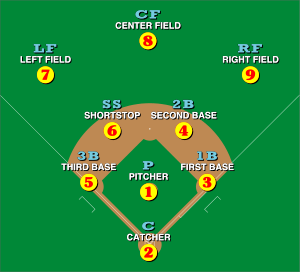In baseball, an earned run is any run that was fully enabled by the offensive team's production in the face of competent play from the defensive team. Conversely, an unearned run is a run that would not have been scored without the aid of an error or a passed ball committed by the defense.
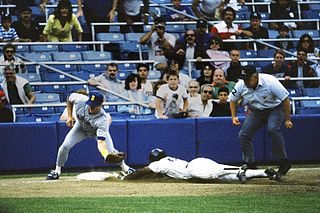
In baseball, a stolen base occurs when a runner advances to a base unaided by other actions and the official scorer rules that the advance should be credited to the action of the runner. The umpires determine whether the runner is safe or out at the next base, but the official scorer rules on the question of credit or blame for the advance under Rule 10 of the MLB's Official Rules.
In baseball, fielder's choice refers to a variety of plays involving an offensive player reaching a base due to the defense's attempt to put out another baserunner, or the defensive team's indifference to his advance. Fielder's choice is not called by the umpires on the field of play; rather, it is recorded by the official scorer to account for the offensive player's advance without crediting him with an offensive statistic such as a hit or stolen base.
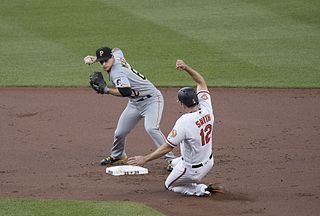
In baseball and softball, a double play is the act of making two outs during the same continuous play. Double plays can occur any time there is at least one baserunner and fewer than two outs.
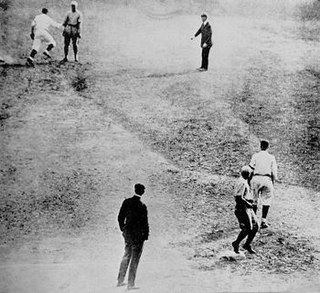
In baseball, an unassisted triple play occurs when a defensive player makes all three outs by himself in one continuous play, without his teammates making any assists. Neal Ball was the first to achieve this in Major League Baseball (MLB) under modern rules, doing so on July 19, 1909. For this rare play to be possible there must be no outs in the inning and at least two runners on base, normally with the runners going on the pitch. An unassisted triple play usually consists of a hard line drive hit directly at an infielder for the first out, with that same fielder then able to double off one of the base runners and tag a second for the second and third outs.

In the game of baseball, the official scorer is a person appointed by the league to record the events on the field, and to send the official scoring record of the game back to the league offices. In addition to recording the events on the field such as the outcome of each plate appearance and the circumstances of any baserunner's advance around the bases, the official scorer is also charged with making judgment calls that do not affect the progress or outcome of the game. Judgment calls are primarily made about errors, unearned runs, fielder's choice, the value of hits in certain situations, and wild pitches, all of which are included in the record compiled. This record is used to compile statistics for each player and team. A box score is a summary of the official scorer's game record.

The infield fly rule is a rule of baseball and softball that treats certain fly balls as though caught, before the ball is caught, even if the infielder fails to catch it or drops it on purpose. The umpire's declaration of an infield fly means that the batter is out regardless of whether the ball is caught. The rule exists solely to prevent the defense from executing a double play or triple play by deliberately failing to catch a ball that an infielder could catch with ordinary effort.

A first baseman, abbreviated 1B, is the player on a baseball or softball team who fields the area nearest first base, the first of four bases a baserunner must touch in succession to score a run. The first baseman is responsible for the majority of plays made at that base. In the numbering system used to record defensive plays, the first baseman is assigned the number 3.
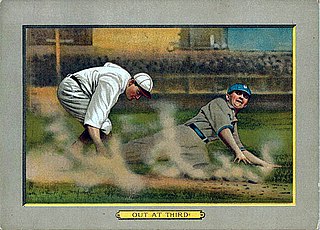
In baseball, an out occurs when the umpire rules a batter or baserunner out. When a batter or runner is out, they lose their ability to score a run and must return to the dugout until their next turn at bat. When three outs are recorded in a half-inning, the batting team's turn expires.

Throughout the history of baseball, the rules have frequently changed as the game continues to evolve. A few common rules most professional leagues have in common is that four balls is a base on balls, three strikes is a strikeout, and three outs end a half-inning.
A hidden ball trick is a play in which a player deceives the opposing team about the location of the ball. Hidden ball tricks are most commonly observed in baseball, where the defence deceives the runner about the location of the ball, to tag out the runner. In goal-based sports, the offence deceives the defence about the location of the ball, in an attempt to get the defence running the wrong way, such as in a fumblerooski.
In baseball, interference occurs in situations in which a person illegally changes the course of play from what is expected. Interference might be committed by players on the offense, players not currently in the game, catchers, umpires, or spectators. Each type of interference is covered differently by the rules.
In baseball, obstruction is when a fielder illegally hinders a baserunner running within the basepath. Baserunners are generally permitted to run from base to base without being physically blocked or hindered by a fielder. The only time that a fielder is not obligated to "get out of the way" of a baserunner is when the fielder is fielding a hit ball or in possession of the ball.

The 1926 World Series was the championship series of the 1926 Major League Baseball season. The 23rd edition of the Series, it pitted the National League champion St. Louis Cardinals against the American League champion New York Yankees. The Cardinals defeated the Yankees four games to three in the best-of-seven series, which took place from October 2 to 10, 1926, at Yankee Stadium and Sportsman's Park.

In baseball, a pickoff is an act by a pitcher or catcher, throwing a live ball to a fielder so that the fielder can tag out a baserunner who is either leading off or about to begin stealing the next base.

Baseball scorekeeping is the practice of recording the details of a baseball game as it unfolds. Professional baseball leagues hire official scorers to keep an official record of each game, but many fans keep score as well for their own enjoyment. Scorekeeping is usually done on a printed scorecard and, while official scorers must adhere precisely to one of the few different scorekeeping notations, most fans exercise some amount of creativity and adopt their own symbols and styles.

Eric Kevin Bruntlett is an American former professional baseball utility player, who played in Major League Baseball (MLB) for the Houston Astros and Philadelphia Phillies. Bruntlett is perhaps best remembered for executing an unassisted triple play in 2009.
In baseball, the fourth out is a legal out made by the defence after three outs in a half-inning have already been made. According to the rules, the third out does not cause the ball to become dead; if the fielders make a subsequent out that prevents a run from scoring, this out will supersede the apparent third out, thus becoming the recorded third out. For statistical purposes, the apparent third out is "undone" and the fourth out's result is recorded instead. With the advent of video replay appeals, a new rationale for making extra out(s) has emerged: insurance against a prior out being undone on appeal. These fourth-out situations are not the same as four strikeouts in an inning.
The wheel play is a defensive strategy in baseball designed to defend against a sacrifice bunt. The play's name derives from the wheel-like rotation of the infielders.





